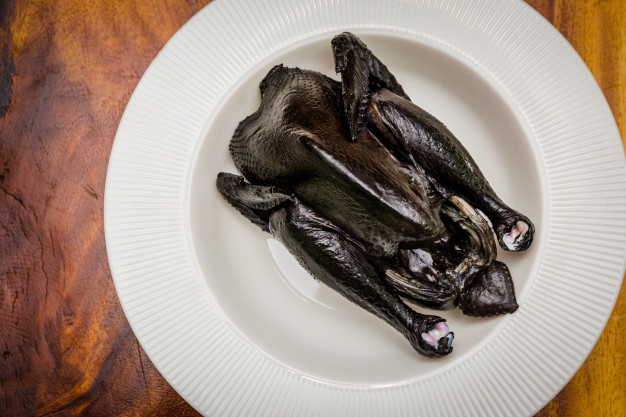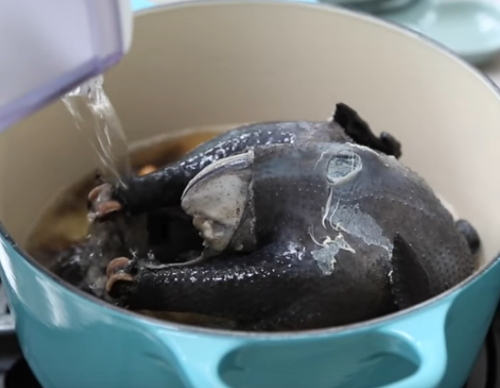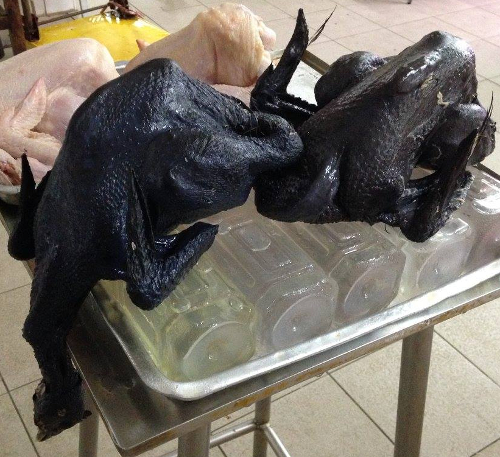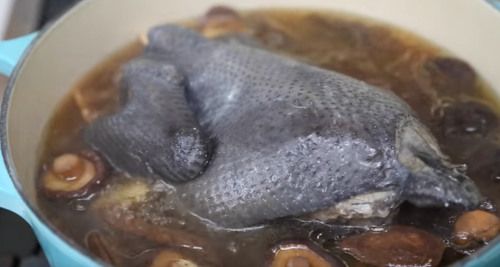Keeping silkies for meat

Can you keep Silkie chickens for meat?
The Silkie is not everyone's idea of a dual purpose bird but they are a delicacy in the Orient. The skin and meat is black which is why you rarely see them for sale as food, it freaks some people out.
They can be eaten and the meat tastes a little stronger than normal chicken. So if any one is curious they should try one, will be something completely different.
Below: A Silkie simmering whole in a saucepan to make soup.

I know quite a few people who like them as dual purpose chickens, They are small, docile and easy to handle, don't require much feed, and lay very large-yolked, delicious eggs, while also yielding excellent meat and broth with unusually nutritious properties. Silkie broth is considered medicine in China.
I do know a few people who find them simply too cute to eat as well.
Things to know about keeping Silkies for meat:
- Financially it is not really worth it, they take a long time to grow out and they are small.
- The Silkies are usually about 1 lb at the market, but a live 3 lb bird will dress out at 1.5 but cost more to raise.
- They are used medicinally for soup so the soup is drank and the bird is pretty much shredded at the bottom of the pot.
- The light/dark meat ratio is the same as regular chickens.
- The black is just pigment in the connective tissue which occurs in skin, bones, and within the meat.
- Treat them just like regular chicken unless there is some special presentation that is required.
- Eastern cultures use the head, feet and some of the innards.
- It's just like any other chicken other than pigment and as bony as any other bantam you eat.
What weight do Silkies get to?
Unless you have the larger types then Silkies produce a tiny carcass. About a pound dressed if you're lucky at 6 months on a cockerel.
Below: 2 Silkies cleaned, plucked and dressed, ready to be eaten.

They have very small breasts like any breed that hasn't been selected for huge ones. At 30 weeks my large surplus Silkie cockerels finished at about 2 1/2 lbs when processed.
What is the best age to process a Silkie?
Between 6 and 12 months of age. Much younger than this and they will be too small and not have filled out at all.
Older than 1 year and they may be quite tough. Do those who eat them eat their skin as well?
You can eat the skin off a Silkie, it is normally removed from the broth or soup before serving. The skin and bones are used in the cooking for extra flavour but are removed before serving.
If you roast the bird the skin cooks the same as on any other chicken, the only difference in the colour.
Are there any special considerations for feed or during processing?
Do a little research before butchering a Silkie, the skin is dark grey to black, the bones are black and the meat is very dark. Bright yellow fat against a grey/black background is strange to look at.
Chickens killed for home use, where poultry is only reared in a small way, will be ready for table any time after about four months old, depending on the breed and personal preference.
If they have been thoroughly well fed from the shell, they will need no further fattening at all.
They should simply be fasted for about eighteen hours before being killed. This ensures the digestive tract is empty for processing.
The simplest and most certain way of avoiding unnecessary suffering is to chop the head off, after which there can be no consciousness. The fact that even after such an operation, a chicken will sometimes run and flutter about all over a yard, is a simple proof that such “reflex” muscular action does not necessarily denote suffering when fowls are killed in other ways.
Fowls should be plucked at once, whilst still warm as the feathers then come out much easier. The small hairs are then singed off with a piece of lighted paper or a candle. Some people dip them just one instant in boiling water but this practice is not universal.
From my experience plucking a Silkie sucks. Wet Silkie feathers stick to stuff so bad I'd prefer to dry pluck if plucking is needed. I just skin out all birds.
How does the meat compare to other chicken or other meats in general?
Silkies are a delicacy in the Asian community, especially with the Chinese. Silkies are more for a medicinal purposes much like normal chicken soup when one is feeling under the weather but with more health benefits.
It is often boiled whole , but can be portioned into pieces with bones if you are using the larger bird.
Below: Silkie broth.

Use lots of herbs stuff in the cavity or just in the broth and cook for a good 30 -45 minutes or longer till fully cooked and tender.
Silkies the only kind of chickens with black meat, there are many black skinned breeds.
Silkie meat tastes just like chicken but with a stronger and leaner taste but still very delicious. But not only is it made into soup but many other various way including curry.
What is different about Silkie chicken meat?
Silkie meat is black.
The interesting thing about Silkie meat is the high levels of carnosine, a naturally occurring peptide which is sold as a dietary supplement. People take it to increase muscle mass, ward of the effects of ageing and alleviate diseases like diabetes or autism. Studies have shown the black chicken is one of the richest sources of carnosine.
Silkie chicken recipes:
On a TV cooking show I heard that in France they soak them in Cognac and then pot roast and eat.
They are most commonly made into soup, this leaves the meat tender.
Below: A bowl of soup made from Silkie meat.

Any chicken recipe can be adapted for Silkies.
I found this about cooking Silkies in an old poultry book from 1906:
"Let them be gently boiled or simmered, nearly an hour for each year of their age, after which they can be roasted if preferred. Unless very aged, they will then be tolerable eating."
What does Silkie meat cost?
Fresh ones can fetch $20 a bird. Silkie meat is considered a delicacy.
Producing black meat crosses:
So how do you go about breeding a dark meat or FM broiler?
Fibromelanosis is a mutation in domestic chickens has been known for centuries in Southeastern Asia and Europe, expressed with abnormal accumulation of the dark pigment melanin in the dermis and connective tissue formations of the chicken.
If black meat broilers is what you want then it is a better proposition to breed the black skin gen FM (Fibromelanosis) to a strain of broiler rather than raising slow growing and small chickens like a Silkie.
To me Silkies taste like regular chicken, the FM gene wont alter the taste, just the colour.
First you have to raise a dozen or so Silkie chicks and the matching number of broiler chicks. Don't give them broiler feed, keep them fed with layer or breeder pellets. Make sure they are without feed for a few hours in the day a swell, you do not want them to fatten.
After 12 or so weeks keep the largest 2 Silkie roosters and the healthiest looking dozen broiler hens. Make 2 breeding groups and cull the rest.
Start hatching as soon as the males have done their thing. The result of this first cross is that all the males will have light skin colour and light coloured shanks, but the females will have dark skin colour and dark coloured shanks.
Because the males are heterozygous for FM/fm ID/id+ and the Females are heterozygous FM/fm id+/- . More on chicken genes and genetics here.
The dominant sex-linked inhibitor dermal melanin ID will mask the presence of Fibromelanosis so the hens show dark skin because they get their only id+ sex linked gene from the male.
Choose the biggest, fattest and fastest growing cockerel and 6 hens and mate them together.
You need to hatch a lot chicks this time, more than 60 if you can. This second or F2 cross will give you 25% light skin roosters and 25% light skin hens.
Remove the light skinned birds and the rest of roosters and hens will all have dark skin and dark shanks. Keep them for your breeding pen.
You will need to make one more selection as 1 in 16 birds in the third year will revert to light skinned types.
